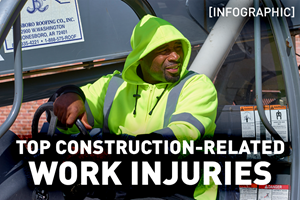Which industries have the most OSHA incidents? You might think that the answer to the question is manufacturing, which is relatively accurate as manufacturing represents 15% of all workplace injuries in 2019. However, as we will discuss more below, some industries have a higher percentage of injury incidents.

Injuries to workers are an unfortunate part of doing business. However, some dangerous industries and occupations are known for being more prone to workers becoming injured. Thankfully, there is plenty of data to help establishments understand where extra caution should be placed on keeping workers safer and better protected. For many occupations, wearing specific personal protective equipment (PPE) is an absolute must, which is where MCR Safety enters the picture.
This article will dive into injury data offered by well-known government agencies, such as the Bureau of Labor Statistics (BLS) and OSHA.
BLS Injury Rates

When digging into Bureau of Labor Statistics (BLS) incident numbers, the critical criteria for comparing numbers year-over-year and between industries is the injury rate. It is calculated by multiplying the total number of injuries per year by 200,000 and dividing that by the total number of employee labor hours worked.
The injury incident rate helps companies understand if their workplace injuries are in line with the industry average for injuries. If the company is experiencing significantly higher incidents than the industry average, some drastic steps will need to occur.
OSHA

The OSHA recordable incident rate is different for every industry employing workers. What is a good OSHA incident rate? Any injury that occurs isn't good, especially for the person sustaining the wound. However, it's unrealistic to think there will be no injuries within any industry. It's always best to review comparable industries when determining the answer to this question. You would not compare a construction sub-industry to a financial firm. The risks found in each sector are entirely different.

Which industries have the most OSHA incidents? Keep in mind, OSHA incident numbers are pulled from the data assembled by the BLS. In addition, though, they've created an additional list of industries on their radar due to the number of injuries.
OSHA's every day focus centers around reducing the number of injuries experienced across U..S industries. Here are two of the main criteria they use to determine whether an industry needs to be targeted:
- 5,000 total injury and illness cases
- Industries with an injury rate 3.0 or higher
These industries have been targeted by OSHA due to meeting their overall injury criteria:
- Concrete
- Fruits and Vegetables
- Landscaping
- Oil and Gas
- Primary Metals
- Ship Building and Repair
- Warehousing
Non Fatal Injuries

The total number of nonfatal workplace injuries and illnesses reported by the BLS was 2.8 million. That works out to a rate of 3.0 cases per 100 equivalent full-time workers, including government workers. 2.8 is the incident rate for all of the private industry.
Goods-producing industries come in with a higher incident rate at 3.1, compared to service-providing industries at 2.6
Industry Injuries

As you can imagine, many industries go over the overall average for injuries. Here are some of the highest incident rates by the industry for 2019.
Industry Incident Rate
- Agriculture, forestry, fishing, and hunting: 5.2
- Warehousing: 4.4
- Manufacturing: 3.3
- Construction:2.8
- Mining, quarrying, and oil/gas extraction: 1.2
Most would think that the manufacturing injury rates would be the highest. However, as you see from the numbers above, Agriculture and warehousing have a higher incident rate. Farm accidents are one of the primary contributors to the agriculture number being so high.
However, one thing to always keep in mind is that both construction and manufacturing employ a large workforce. So, even though the incident rate % is smaller, the number of occupations suffering injuries is higher.
Also, the BLS breaks down the incident rate by the NAICS sub-industry too. Here is a look at industries that have the most concerning incident rate:
Industry Incident Rate
- Prefabricated building manufacturing - 13.8
- Nursing - 11.5
- Steel Foundries - 10.7
- Hospitals - 8.8
- Hog and pig farming - 7.5
- Dried food manufacturing - 7.5
- Framing - 7.0
- Seafood packaging - 6.9
- Correctional Institutions - 6.8
Census of Fatal Occupational Injuries (CFOI)

What is the BLS CFOI? It is an assembled report on fatalities across all 50 U.S. states. The reported National Census of Fatal Occupational injuries in 2017 was 5,190. We highlight this last number first to show how the total number of fatalities is increasing every year. And, as shown below, the numbers continue to rise across over multiple years analyzed.
The total number of fatal work injuries in 2019, the latest available data, came in at 5,333, representing an increase of 2% over the previous year. What's concerning is that the number of fatal injuries has been increasing in recent years and is the highest number recorded since 2007. Here are the top five industries with the most fatalities:
Industry Fatalities
- Construction - 1061
- Transportation and Warehousing - 913
- Agriculture - 573
- Government - 426
- Retail - 291
CFOI data from other reported years:
- Fatal occupational injuries in 2014 - 4,679
- Fatal occupational injuries in 2016 - 4,836
- Fatal occupational injuries in 2017 - 5,190
- Fatal occupational injuries in 2018 - 5,250
Data has been compiled since 1992. You can find all reports by visiting the following BLS page.
Occupational Injury

According to the BLS, the occupational injury definition is when any wound occurs while at work. When you begin to analyze occupational injuries, ten occupations make up over 33% of all injuries. Those who are responsible for moving materials experience the most, with 64,160 injuries.
The most fatalities occur from construction and extraction workers, reporting 1,061 total in 2019, representing a 5% increase over the previous year. In addition to construction workers, grounds maintenance workers saw a significant rise in fatalities, with 229 reported.
Here are some additional occupations that experience a high number of fatalities:
Occupation Injuries
- Farming, Fishing, and Hunting - 293
- Landscaping - 124
- Roofers - 111
- Law Enforcement - 97
- Tree Trimmers - 97
Compare Your Numbers to Your Industry

Where can I find BLS injury rate data for my industry? Safety Management Group provides a handy incident rate calculator. Enter your industry, total number of injuries and illnesses, the number of hours worked by all employees, and it will provide your OSHA Incident Rate.
You can also find the entire industry list by NAICS sub-industries by going here.
Common Questions

What is incidence rate?
- When examining injuries across U.S. industries, is the number of injury events that occur over a period of time, typically a full year.
Where does BLS injury and illness data come from?
- Annual injury data reported by the BLS comes from the Survey of Occupational Injuries and Illnesses and the CFOI.
What is non fatal fall injury?
-
Falls, including slip and trips, saw an uptick in injuries for 2019, with 880 total injuries.
How to calculate OSHA incident rate?
- The incidence rate provided by OSHA is the same number provided by the BLS. It is calculated by multiplying the total number of injuries per year by 200,000 and dividing that by the total number of employee labor hours worked.
MCR Safety: We’ve Got You Covered
.png?h=433&w=400&hash=AAE58F738B22B3E28A3F2687B2D73DE6)
When it comes to personal protective equipment (PPE), we’ve got you covered. Whether it’s gloves, glasses, garments, or all three, you can find them at MCR Safety. Our goal is to help lower the above yearly injuries experienced by workers. If you need any assistance with better understanding the PPE you need to be wearing, please schedule a consultation with our 360 specialists.
We welcome any comments, feedback, or suggestions for how we can best protect people at work.
For over 45 years, MCR Safety has proven to be a world leader in gloves, glasses, and garments. Whether it's on the shop floor, an oil rig, or a construction site, we are there to provide solutions to workplace hazards. It's all part of our commitment to protect people.
No matter your industry, we have the personal protective equipment you need.

Learn more about MCR Safety by checking out our most recent video. For more information, browse our website, request a catalog, find a distributor, or give us a call at 800-955-6887.

Top Construction-Related Work Injuries
Get the real stats! Learn what the top injuries are within the construction industry. Knowing is half the battle of keeping you safe.
About the Author
Related Articles

Shining a Light on Ladder Safety
Ladders are one of the most beneficial tools a worker will ever use. However, like all tools,...
The Importance and Significance of ANSI Standards
The ANSI standards drive the decision-making and development of all personal protective equipment...
Understanding ANSI Z87.1
ANSI/ISEA Z87.1-2020, the sixth revision of the voluntary eye and face protection standard,...
CDC and Its Role in Protecting Americans’ Health
When it comes to issues affecting Americans' health and safety, people turn to the guidance...Latest Articles






